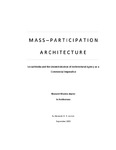Mass-participation Architecture: Social Media and the Decentralisation of Architectural Agency as a Commercial Imperative
| dc.contributor.supervisor | Murrani, Sana | |
| dc.contributor.author | Lorimer, Alexander | |
| dc.contributor.other | School of Art, Design and Architecture | en_US |
| dc.date.accessioned | 2016-08-12T13:31:46Z | |
| dc.date.available | 2016-08-12T13:31:46Z | |
| dc.date.issued | 2016 | |
| dc.identifier | 10216469 | en_US |
| dc.identifier.uri | http://hdl.handle.net/10026.1/5293 | |
| dc.description | Full version unavailable due to 3rd party copyright restrictions | |
| dc.description.abstract |
A key problem in the field of architecture and urban planning since the 1960s has been the marginal role played by the general public in directly shaping significant aspects of the built environment. This thesis draws on theories around participatory planning, and in particular, the seminal 1969 publication ‘Non-plan: An Experiment in Freedom’. Non-plan suggested the potential of digital technology to facilitate self-organising public participation in architectural design and urban planning, while also taking inspiration from consumer- responsive activities across commercial disciplines. Now, half a century later, advancing web-technologies are beginning to facilitate mass-participatory design as a commercial imperative, and nowhere is this trend more visible or revealing than in the development of consumer products. The aim of this thesis is therefore to use these developments in the consumer goods industry to investigate the implications and consequences of significantly decentralising architectural design agency through the use of social media. The thesis method is to undertake a comparative study of both the design disciplines of commercial architecture and consumer goods. Commercial architecture has inherited the selling imperative of the consumer goods industry; and, in this thesis, the commercial imperative towards mass-participatory consumer product design acts as a basis for a contemporary evaluation of architecture’s Non-plan theory. Throughout the research chapters interview content from notable architectural figures, as well as empirical exploration of mass-participatory design platforms, is combined with participatory planning theory and up-to-date information from relevant business and technology periodicals. Establishing a series of political and economic hurdles, as well as advantages to the emergence of mass-participation architecture, it is concluded that Non-plan’s free-market concept will come to present an increasingly viable approach to the practice of architectural design; given appropriate regulatory conditions, and against the backdrop of the rapidly developing culture and technologies encompassed by social media. In this context it is argued that architects will find themselves acting less as social interpreters, but more as stimulators, mediators and coordinators of a significantly larger, more insightful, and profoundly productive collective; one that is composed of participants from the general public. | en_US |
| dc.language.iso | en | en_US |
| dc.publisher | Plymouth University | en_US |
| dc.subject | mass-participatory design | en_US |
| dc.subject | mass-participation | en_US |
| dc.subject | collective intelligence | en_US |
| dc.subject | web-based | en_US |
| dc.subject | crowdsourcing | en_US |
| dc.subject | product design | en_US |
| dc.subject | consumer goods | en_US |
| dc.subject | retail | en_US |
| dc.subject | architecture | en_US |
| dc.subject | non-plan | en_US |
| dc.subject | incrementalism | en_US |
| dc.subject | decentralisation | en_US |
| dc.title | Mass-participation Architecture: Social Media and the Decentralisation of Architectural Agency as a Commercial Imperative | en_US |
| dc.type | Masters | en_US |
| plymouth.version | Edited version | en_US |
Files in this item
This item appears in the following Collection(s)
-
01 Research Theses Main Collection
Research Theses Main


